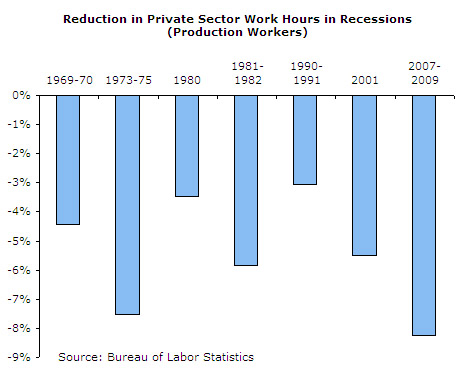September 04, 2009
By Dean Baker
September 4, 2009
The 10.1 percent unemployment rate for adult men equals the prior post-war high.
The unemployment rate hit 9.7 percent in August, up from 9.4 percent in July. According to the establishment survey, the economy shed 216,000 jobs in August. In addition, the job loss numbers for June and July were revised up by 49,000. This puts the average rate of job loss over the last three months at 318,000 per month.
The rise in unemployment in August was disproportionately among men, with the unemployment rate for adult men rising to 10.1 percent. By comparison, the unemployment rate for adult women is 7.6 percent. Before the recession, the unemployment rates for men and women were essentially equal. The 10.1 percent unemployment rate for adult men is equal to its previous post-war high in December of 1982.
Underemployment also rose in August, with another 298,000 workers involuntarily working part-time. This number now stands at 8.9 million, or 5.8 percent of the labor force. This is the same rate as the prior peak in January of 2003. Most of the other data in the household survey is consistent with a labor market that is still weakening. The percentage of unemployment attributable to voluntary quits dropped to 5.5 percent, another record low. The number of discouraged workers is almost exactly double the August 2008 number. And the U-6 measure of labor market slack rose to 16.8 percent, 0.3 percentage points above the 16.5 percent peak hit in June.
The slower rate of job loss is the result of further moderation in the pace of job loss in the sectors that have been the biggest job losers. Construction lost 65,000 jobs in August, down from 119,000 per month between October and March. Most of this job loss is now coming from the non-residential sector. This is not surprising since residential construction has stabilized in the last couple of months, while a glut in the non-residential market is leading to a sharp contraction in this sector. Stimulus-related jobs will be an offsetting factor.

Hours for production workers have been reduced by 8.5 percent over the course of this recession. This is the largest percent reduction of hours during a recession since the Great Depression.
Manufacturing lost 63,000 jobs in August. Job loss in the sector had averaged 181,000 a month between October and March. Some of this job loss was a fluke of seasonal adjustment, as the July employment levels in the auto industry were almost certainly overstated, leading to a reported loss of 14,800 jobs this month. Employment in the auto sector is likely to be stable or up slightly through the rest of the year.
Retail trade lost just 9,600 jobs in August, compared to a 69,000 monthly rate of job loss last winter. Auto dealers actually added 5,200 jobs to deal with the Cash for Clunkers program. Employment services shed 10,500 jobs in August, down from an 84,000 monthly rate earlier in the year.
It is worth noting that the number of jobs imputed into the data for new firms continues to exceed the number for the corresponding months of 2008. The total difference over the last three months has been 53,000. It seems unlikely that new firms would be adding more jobs this year than last year.
Health care continues to add jobs at a rapid pace, with employment increasing by 27,900 in August. On the other side, state and local governments lost 13,000 jobs, as the negative effect of their huge budget shortfalls outweighed the positive impact of the stimulus.
One bright spot in the report was a 0.3 percent increase in the average hourly wage. Over the last quarter, hourly wages have risen at a 1.7 percent annual rate. This is somewhat of an uptick from prior months in which nominal wage growth had virtually stopped. The rise in the minimum wage was likely a factor, with the average wage in retail rising by 1.0 percent in August. If wage growth is sustained, then it can help boost consumption going forward.
This report, like the prior three reports, shows a slowing pace of job loss. It is important to recognize that this rate of job loss, especially when adding in the upward revisions, would be considered disastrous at any other time. The labor market is still deteriorating, albeit less rapidly.
Dean Bakeris the Co-director of the Center for Economic and Policy Research. CEPR’s Jobs Byte is published each month upon release of the Bureau of Labor Statistics’ employment report. For more information or to subscribe by fax or email contact CEPR at 202-293-5380 ext. 102, or chinku [at] cepr [dot] net.






